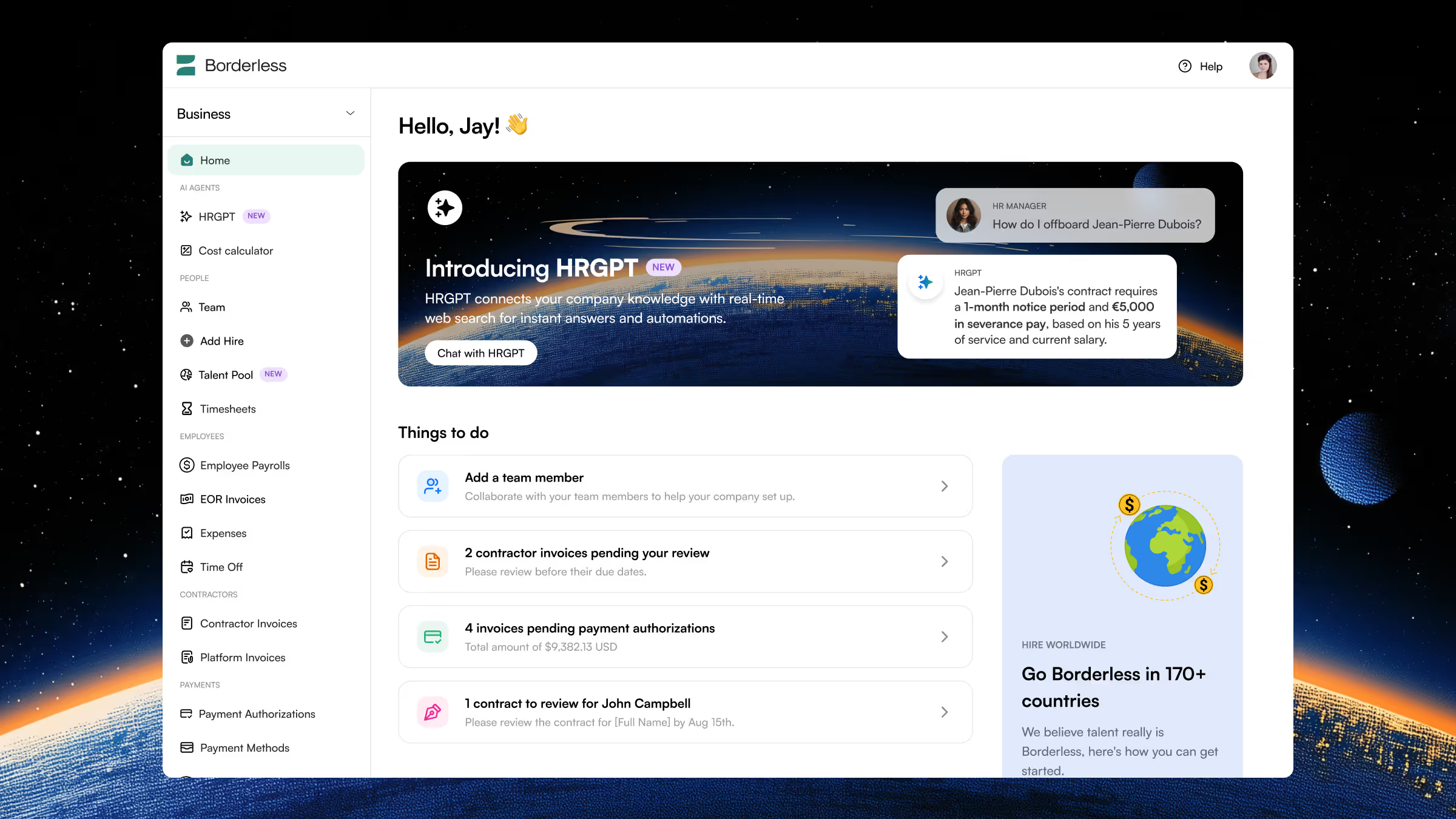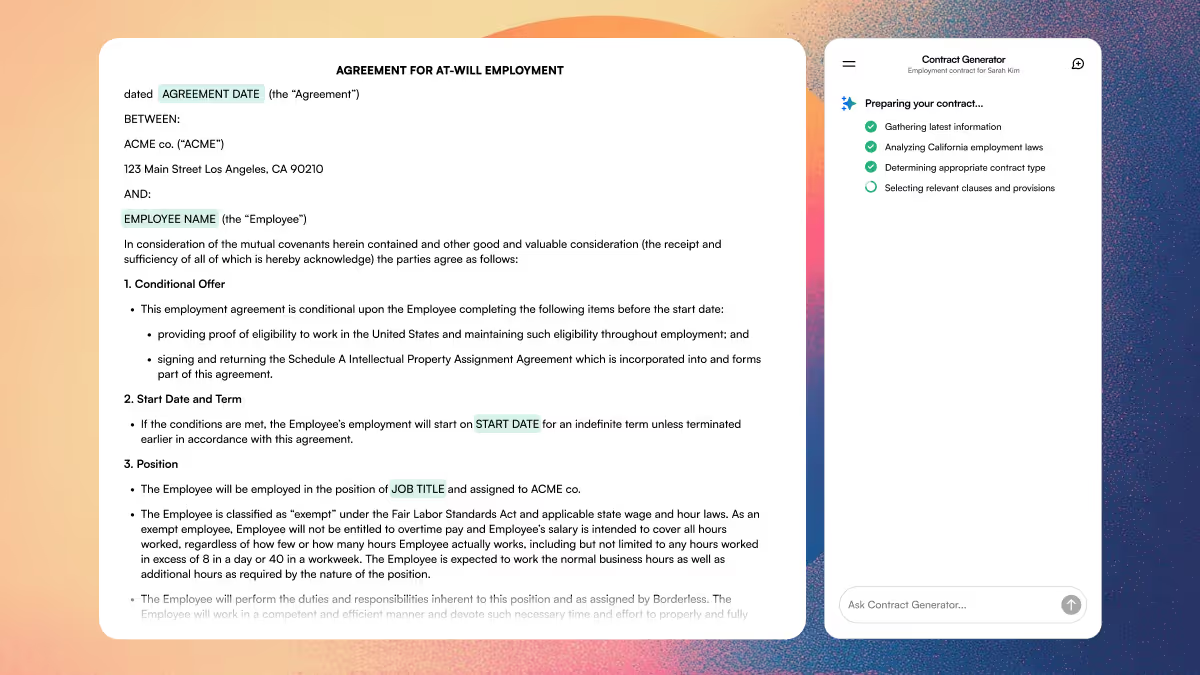Navigating the world of global hiring can feel overwhelming, especially as compliance requirements grow more complex. With countries frequently updating labour laws, tax regulations, and data privacy standards, it’s easy to feel the pressure of keeping up. If you’re striving to get everything right from the start, you’re in good company, many employers face the same challenges as they balance business growth with ever-evolving rules.
This blog will guide you through practical solutions for managing global compliance, including how partnering with a global employer of record can simplify the process. You’ll discover how this approach allows you to hire top talent in new countries, even without a legal entity, while leaving the complex paperwork and legal details to the experts. By the end, you’ll have a clearer path to building your team and expanding your business with confidence.
What Is an Employer of Record for Global Onboarding
An Employer of Record (EOR) is a company that legally employs workers on behalf of another business. When a company uses an EOR, the worker is officially employed by the EOR but performs work for the client company.
The client company directs the employee's daily tasks and responsibilities. The EOR handles all the legal paperwork, payroll, benefits, and compliance requirements in the worker's country.
For onboarding new international hires, the EOR manages everything from creating employment contracts to setting up payroll and benefits. This makes it possible to hire someone in another country without setting up a local legal entity.
An EOR handles these key responsibilities during onboarding:
- Legal employment: Creating compliant employment relationships in the worker's country
- Documentation: Managing contracts, identity verification, and local paperwork
- Payroll setup: Setting up tax withholding and payment systems
- Benefits enrollment: Registering employees for required and optional benefits
This arrangement allows companies to focus on integrating the new hire into their team while the EOR manages the legal and administrative details.
Why Businesses Choose an EOR for Speed and Simplicity
Companies use an Employer of Record when they want to hire in countries where they don't have a legal presence. This eliminates the need to register a local business entity or build internal teams to manage different employment laws.
Modern EORs use technology to speed up tasks that were previously done manually. Contract generation, document collection, and benefits enrollment now happen through digital platforms that reduce errors and save time.

1. Rapid Setup in New Markets
Setting up a legal entity in a new country typically takes 3-6 months. The process involves:
- Registering with government authorities
- Opening local bank accounts
- Hiring legal and tax experts
- Establishing accounting systems
An EOR can complete hiring in days rather than months. This speed gives companies a competitive advantage in global workforce management, allowing them to respond quickly to business opportunities and talent availability.
2. Reduced Administrative Burden
Each country has unique employment requirements. Managing these differences requires specialized knowledge and significant time investment.
EORs handle complex administrative tasks such as:
- Creating country-specific employment contracts
- Processing payroll in local currencies
- Managing mandatory and supplementary benefits
- Maintaining compliant employee records
This allows company HR teams to focus on strategic priorities rather than administrative paperwork.
3. Minimizing Compliance Risks
Hiring internationally comes with significant compliance challenges. These include:
- Permanent establishment risk: The possibility of being taxed as if your company has a full business presence
- Worker misclassification: Incorrectly treating employees as contractors
- Data privacy violations: Failing to follow local data protection laws
EORs stay current with local regulations and update their processes when laws change. This approach to international compliance protects companies from legal penalties and reputational damage.
Understanding the 2025 Onboarding Timeline
In 2025, EOR onboarding is fast and technology-driven. Tasks that once took weeks now take days. The best EORs complete standard onboarding in under 72 hours.
AI and automation handle document collection, contract generation, and compliance checks. Digital systems reduce delays and improve accuracy. The process follows a clear sequence from pre-offer to post-hire support.
1. Pre-Offer Preparations
Before making a formal offer, the company and EOR establish employment terms. This includes defining the role, compensation, and benefits. AI tools check for compliance issues early in the process.
Key preparation activities include:
- Position scoping: Defining job requirements and compensation
- Compliance assessment: Identifying country-specific legal requirements
- Cost calculation: Determining total employment costs, including taxes and benefits
- Timeline planning: Setting realistic onboarding schedules
These preparations create a clear roadmap for the hiring process.
2. Formal Offer and Contract Generation
Once terms are agreed upon, the EOR creates a legally compliant employment contract. Modern EORs use AI systems to generate contracts in minutes rather than days.
The employee provides required documents through secure digital platforms. E-signature tools complete the process quickly and legally. Clear communication during this phase helps prevent confusion and delays.
The focus is on creating compliant employment contracts and collecting necessary information efficiently.
3. Day One Onboarding Experience
On the employee's first day, onboarding happens through a digital portal. The experience is consistent regardless of location. The EOR and client company coordinate to provide system access, equipment, and training.
Equipment and account setup are completed before the start date. The employee receives clear instructions from both the EOR and the client company.
This step helps the employee understand their role and begin working productively from day one.
4. Post-Onboarding Support
After initial onboarding, the EOR provides ongoing support. This includes answering questions about payroll, benefits, and compliance issues.
Some EORs offer cultural orientation and local guidance. These services help employees understand workplace norms and company values.
This continuous support is an important part of global team management and helps maintain accurate employment records.
Top Compliance Factors Every EOR Must Address
Compliance is the foundation of EOR services. It involves following legal requirements for hiring employees in different countries. These requirements cover employment contracts, taxes, benefits, and workplace policies.
Modern EORs use technology to track regulatory changes and apply them to employment practices. Some platforms use AI to identify errors, monitor updates, and flag risks before they become problems.
Key compliance areas that EORs manage during onboarding include:
- Employment contracts: Country-specific terms and conditions
- Tax registration: Proper setup with local tax authorities
- Mandatory benefits: Required insurance, leave, and retirement programs
- Working hours: Compliance with local regulations
- Data privacy: Protection of employee information according to local laws
- Termination provisions: Legally compliant separation processes
These compliance factors ensure that employment relationships start on solid legal ground and remain compliant throughout the employee's tenure.
Steps to a Friendly AI-Powered Onboarding Experience
AI has transformed how EOR onboarding works. It completes tasks faster and more accurately than manual processes. AI systems manage contracts, payroll, and benefits while reducing errors.
The goal isn't to replace human support but to enhance it. Technology handles routine tasks while people focus on providing guidance and answering questions.
1. Automated Contract Generation
AI-powered HR systems create legally compliant contracts by analyzing local employment laws. These systems check that contracts include all required terms:
- Job title and description
- Compensation details
- Benefits entitlements
- Working hours
- Termination clauses
When laws change, the AI updates contract templates automatically. This reduces legal risks and speeds up the hiring process.

2. Real-Time Payment Processing
Traditional payroll systems operate on monthly cycles with significant delays. Modern EOR platforms use real-time payment technology to process payroll faster.
These systems handle currency conversion and tax calculations automatically. This ensures accurate and timely payments across different countries.
Faster payroll processing benefits both employers and employees. It reduces administrative work and improves financial planning.
3. Integrated Benefits Enrollment
Digital EOR platforms include tools for employee benefits administration. These tools help employees select health insurance, retirement plans, and other benefits required by local law.
Employees access options through online dashboards. Some platforms include educational resources to explain different benefit choices.
This streamlined process ensures employees receive all required benefits while simplifying administration for employers.
How to Avoid Red Flags in EOR Selection
Not all EOR providers deliver the same quality of service. Some use outdated processes, lack local expertise, or make unrealistic promises. When evaluating EOR partners, it's important to recognize warning signs that could indicate future problems.
1. Spotting Unrealistic Promises
Some EORs advertise timelines or pricing that don't align with legal requirements. Realistic expectations include:
- Standard onboarding: 2-5 business days for most countries
- Complex cases: 5-10 business days for countries with extensive documentation requirements
- Transparent pricing: Clear breakdown of service fees, employment costs, and any additional charges
Claims of instant onboarding or unusually low costs often indicate corners being cut on compliance or service quality.
2. Checking Data Privacy Standards
EORs handle sensitive employee information including identification documents, tax details, and banking information. Strong data security is essential.
Look for these data security compliance indicators:
- ISO 27001 certification: International standard for information security
- SOC 2 compliance: Verification of secure data handling practices
- Data encryption: Protection for information in storage and transit
- Access controls: Restrictions on who can view employee data
These standards show that the EOR takes data protection seriously.
3. Confirming Local Legal Expertise
Effective EORs have direct knowledge of employment laws in each country they serve. Some providers rely on third-party networks with inconsistent quality.
Signs of strong local expertise include:
- Direct operations in each country
- In-house legal teams for contract review
- Regular updates on regulatory changes
- Support in local time zones and languages
This expertise ensures accurate compliance and responsive support for both employers and employees.
Experience Next-Generation EOR Onboarding
Modern EOR onboarding combines technology and human support to create a smooth experience. Digital tools collect documents, generate contracts, and enroll employees in benefits with minimal manual work. These systems adapt to the requirements of each country.
Onboarding platforms now include multilingual interfaces and country-specific workflows. Some use AI to verify compliance and identify potential issues before they cause delays. Identity verification and e-signature tools confirm employee details securely.
Support includes both automated systems and human contacts. Some EORs assign dedicated onboarding specialists who guide employees through their first weeks. Others provide cultural orientation to help employees understand company values and local work practices.
Borderless AI offers an AI-native platform that supports these modern onboarding practices. The platform includes real-time compliance checks, fast contract generation, and automated payroll processing for global hiring solutions.
FAQs About Employer of Record Onboarding
How does AI technology reduce errors during the EOR onboarding process?
AI technology automatically checks information against local requirements before documents are finalized, identifying missing or incorrect details early in the process so they can be corrected before causing compliance issues or delays.
Can an employer of record platform integrate with existing HR software systems?
Most modern EOR platforms offer API connections and pre-built integrations with common HR software, allowing data to flow between systems without duplicate entry and maintaining consistent employee records across platforms.
What happens if local employment laws change after an employee is onboarded?
Quality EORs continuously monitor regulatory changes in each country and automatically update employment terms to match new requirements, ensuring ongoing compliance without requiring action from the client company.
How do employer of record services handle equipment provisioning for remote workers?
EORs typically offer either direct equipment procurement and shipping services or provide stipends for local purchases, while maintaining appropriate records for tax and compliance purposes regardless of the method chosen.
What role does the client company play in employee performance management with an EOR?
The client company maintains full control over day-to-day work direction, performance evaluation, and career development decisions, while the EOR handles legal employment matters like contracts, payroll, and benefits administration.









